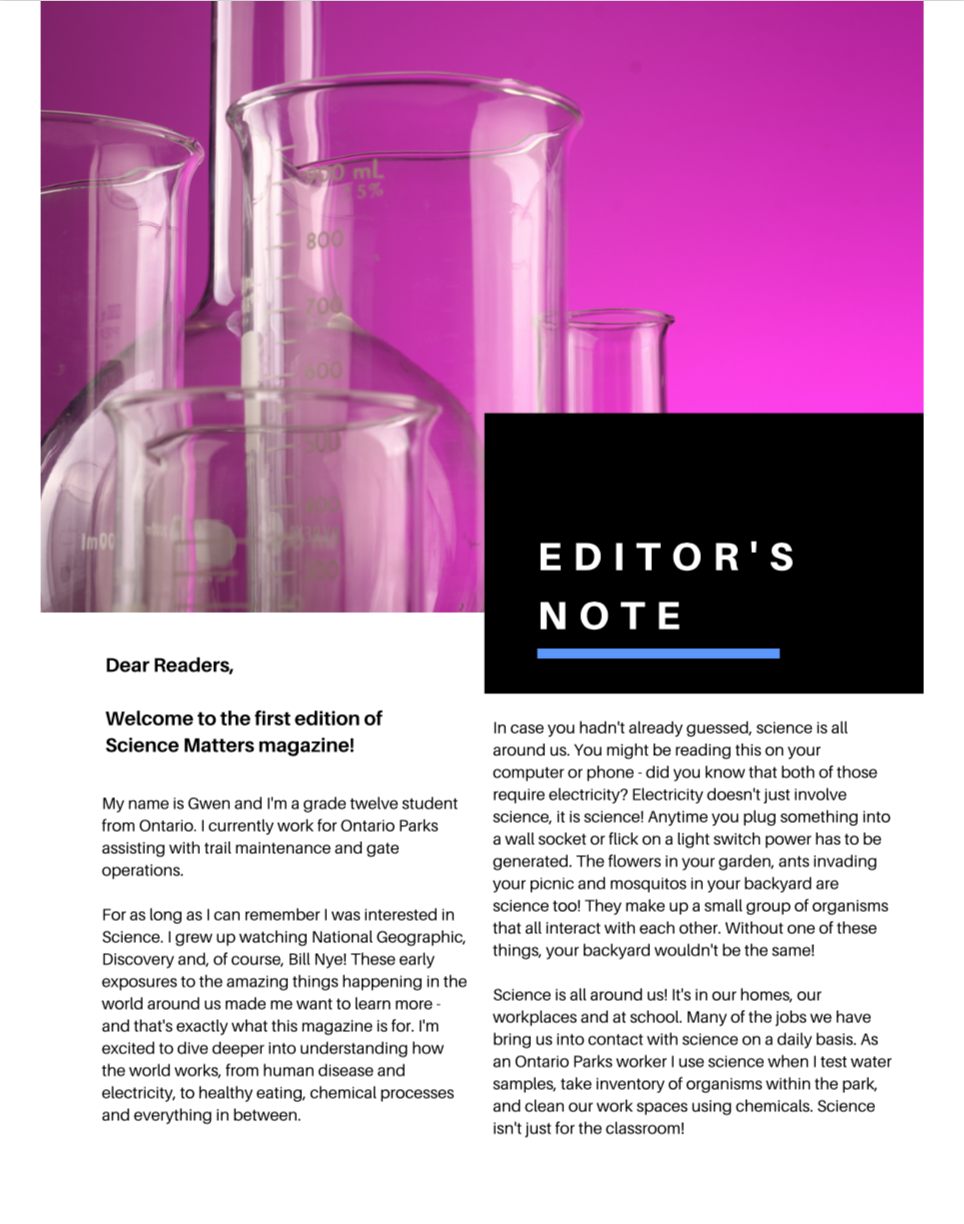Our homes, jobs and schools are full of science principles and ideas, whether we recognize them or not. The goal of this course is to help connect your understanding of science ideas to the world around you. Science isn’t meant to live in a classroom or laboratory. It is quite literally the world around us and the more we begin to recognize this the better prepared we are to think critically, ask questions, and generate our own understanding about how the world works.
Take a minute to consider your current job, if you have one, or a career that you are interested in pursuing after high school. Use the images for inspiration as needed.
What is your job/career choice?
Your answers will vary. The sample answers are based on choosing a career as an Electrician.
Provide a brief description of the job or career.
Your answers will vary. The sample answers are based on choosing a career as an Electrician.
Electricians work on all types of electrical equipment in a range of settings.
What is the education required for the job or career? If you are referring to a job that you currently hold, there may not be set education requirements at present. Consider what education you would need if you wanted to obtain employment permanently in this position. For some jobs, this could be a high school diploma.
Your answers will vary. The sample answers are based on choosing a career as an Electrician. In Ontario, to participate in electrical training programs you need a high school diploma with a grade 12 English credit. Physics and mathematics courses are also recommended.
You can, however, apply into a trades program after Grade 10.
How is science related to this job or career? Try your best to think of a way in which your job or career may use science. We will revisit this question later in the course as well.
Electricians work with and must understand electrical energy. Electrical energy is generated from power stations and electricians must create circuits and systems that can safely harness this energy. The production and use of electricity is science!
Careers in Science, Technology, Engineering and Mathematics (STEM) are highly in demand in today’s world. These careers don’t just involve laboratory science. In fact, they integrate concepts in art, civics, geography, history and everything in between. We will continue to explore various careers involving science and technology as we move through this course.
Making a digital magazine
Your culminating task for this course, worth 15% of your final grade and consists of creating a digital magazine. You will create 12 articles for your magazine by the end of the course.
- Purpose of your magazine: inform your peers about science in the workplace, including careers of personal interest, careers in science, and the relationship between science and our everyday world.
- Audience: other students, friends and family who are interested in the impact of science in the workplace.
The format: A digital magazine
Most information that we as digital consumers take in comes from social media, news media or the internet. Magazines, books and print media are other ways that individuals can gain information about a particular topic or interest.
For your culminating task you will be presenting your information using the format of a digital magazine.
Magazines, both print and digital, are designed to spark your interest in intriguing topics from technology and automobiles, to space, knitting, the environment and anything else. The goal of a magazine is to bring exciting, informative and appealing content to readers.
Review
It is important to understand how your culminating task (Digital Magazine) will be assessed.
Success Criteria:
- Explain the use and impact of science in daily life and in the workplace.
| Level 4 80-100% |
Level 3 70-79% |
Level 2 60-69% |
Level 1 50-59% |
|---|---|---|---|
| With a high degree of effectiveness | With considerable effectiveness | With some effectiveness | With limited effectiveness |
/10
Success Criteria:
- Reflect on and describe ways that science impacts daily life and work using relevant examples.
- Record a list of sources with appropriateness.
| Level 4 80-100% |
Level 3 70-79% |
Level 2 60-69% |
Level 1 50-59% |
|---|---|---|---|
| With a high degree of effectiveness | With considerable effectiveness | With some effectiveness | With limited effectiveness |
/10
Success Criteria:
- Express ideas with fluency.
- Organize ideas in a logical and concise way that is appropriate for an editor’s note.
- Write clearly, without errors in spelling, grammar or syntax.
| Level 4 80-100% |
Level 3 70-79% |
Level 2 60-69% |
Level 1 50-59% |
|---|---|---|---|
| With a high degree of effectiveness | With considerable effectiveness | With some effectiveness | With limited effectiveness |
/10
Total: /30
At a number of spots in the course, you will be instructed to pause and create articles for your magazine. All articles submitted will be read by the teacher and feedback will be provided for you. At the end of the course, you will act on the feedback to improve your articles, and then submit them all for the final culminating activity.
Creating your digital magazine
For your culminating task you have the choice to create a “real” digital magazine using online tools to format and compile information, or a model magazine. To create a digital magazine, you can use a word processing software or you can try free platforms such as Flipsnack, Canva or Lucidpress. Search for applications that are available for you.
Creating a real digital magazine may not be for everyone. Navigating digital platforms can sometimes be confusing, and many may require you to spend some time learning how to use these websites. If this is the case, you may consider using a Word, Google Docs or other word processor to create a “model” magazine. Be sure that you can add text, images, and links as you need them. Regardless if you are creating a “model” magazine or a real digital magazine, be sure to include a magazine cover, and unique title for each article.
Click the platform names to learn more about each one.
Think
Here are some things to consider when choosing your platform:
- Have you read the terms and agreements prior to creating your account?
- Is there an age limit or restriction for this product?
- Will the platform use your personal information or email address for anything other than logging in?
- Does it have the features you want for free, or will it try to sell you more features such as “upgrades”?
- Whichever platform you choose for your magazine, make sure you explore the resources that it offers.
Activity: Writing your first article
Each unit of study will explore different ways in which science impacts your daily life and the ways in which we can ensure that we stay safe and healthy. The overall theme of your magazine is science in the workplace. You will base your articles on the different topics in the course. Science isn’t a field of study that only happens in classrooms and laboratories. It is all around us and ingrained in our everyday lives, from turning on a light switch to making your breakfast in the morning.
Your magazine article will focus on your understanding of the applications of science in the workplace. This is part of your culminating activity for this course. Your magazine will need a title and cover page. You may also want to select colours and a general theme for your magazine at this point. Remember, the focus is science in the workplace.
Let’s start - Article #1
Your first activity for the magazine will be to write an editor’s note. Editor’s notes are usually found at the start of the magazine and provide background information about the content of the magazine.
Include the following in your editor’s note:
- Paragraph 1: Introduce yourself
- Paragraph 2: Describe how science impacts your daily life and the workplace.
Consider the example provided when creating your own editor’s note.

Self-assess as you write using the following rubric.
Sourcing information, media and images for your Digital Magazine
Your digital magazine should be engaging as well as informative. Pictures, images and other media can allow you to make connections with text, evoke emotions, or grab your attention. They can add depth to your writing and allow you to convey and reinforces messages and ideas that may be difficult using words alone.
It is important, however, to consider the source of the images that you use. Not all images are created equally and not all images are free for you to use in your own personal work. The key is finding quality, royalty-free images that can be used to support your writing. If you do decide to use Google for images, be aware that many images have usage rights which means that you may not be able to use them freely.
Explore the following articles to learn more about how to access and use free public domain images in your work and how to reference them properly. You will need to give proper credit, where needed, to any images you may use.
“Give Photo Credit Where Credit Is Due” (Opens in new window)
“How to Attribute Creative Commons Photos” (Opens in new window)
“How to Attribute Creative Commons Photos (accessible version)” (Opens in new window)
Notebook
You will also need a notebook for this course. You may choose to use a paper notebook and handwrite your notes. Or, you may choose to create a document on your computer using Microsoft Word, Office 365 or Google Drive or other word processing software. Consider carefully which works best for you. You should summarize new learning and add notes to the notebook at the end of each learning activity. It is important for learners to actively think and make connections when learning new content. This active thinking, note-taking and brainstorming while reading greatly increases success and comprehension.
You may use a number of different methods for taking notes. These may include:
- Cornell note-taking system
- T-charts
- Sketchnotes
- Mindmaps
Self Check
Time to perform a self-check. Make sure you have done, or can do, the following:
- I have set up a notebook (pen and paper or digital) to take notes and make reflections throughout the course;
- I can describe how to source media, text and images that I use from other sites in my magazine or in my work;
- I have decided on the format/platform that I will use to create my magazine; and
- I have created my first magazine article in the form of an editor’s note.
Go back and review any parts of the learning activity that you are unsure of before moving on to the next one. Include in your self-check notes.






